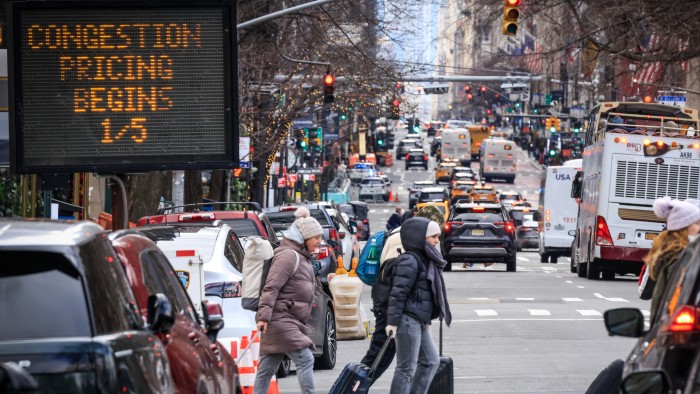Happy Monday, and welcome back to Moral Money. I’m usually behind the scenes editing the newsletter, but I’m breaking through the fourth wall for today’s edition.
To start, more sad news out of California, which saw little relief from wildfires over the weekend; the death toll has risen to at least 24. The blazes across Los Angeles could become the costliest disaster in US history, California governor Gavin Newsom said yesterday.
It’s an inauspicious start to the year after hurricanes, fires and other catastrophes caused $320bn in losses in 2024 — about a third more than the year before.
In today’s newsletter, though, I have an item on something more positive. I looked into how New York’s new congestion pricing scheme could help make subways and trains more resilient before the next extreme weather event hits. Thanks for reading. — Emily Goldberg
Climate adaptation
How congestion pricing supports the resiliency of public transit
The streets outside the FT’s office in downtown Manhattan have been conspicuously quiet in the week since New York City’s long-awaited congestion pricing plan went into effect on January 5.
The headline impact of the new tolling system, which charges a base fee of $9 for passenger vehicles to travel into the central business district south of 60th Street, is that it will reduce traffic by disincentivising emissions-spewing car travel. Another crucial upshot, however, is that it will create a new revenue stream that will, among other things, help the city’s Metropolitan Transportation Authority fortify its infrastructure in the face of climate change.
“In our world [climate adaptation and mitigation] go hand in hand,” said Jamie Torres-Springer, the MTA’s president of construction and development. “We committed to reduce greenhouse gas emissions by 85 per cent by 2040 . . . but we know the most important thing is to keep running service and when we’re seeing increasing vulnerabilities, that’s our focus — the adaptation side of it.”
In New York City, the damage that extreme weather can wreak on public transit was felt acutely during Superstorm Sandy in 2012. Water inundated tunnels and washed out train tracks, rendering some services unusable for days. The single storm cost the MTA $5bn in damages.
But it can take a lot less than a superstorm to turn subway stations into lakes or cause storm water to rain down on a subway platform through the street vents above. Making the system more resilient is an ongoing expense.
In its Climate Resilience Roadmap published last year, the MTA outlined the system’s biggest vulnerabilities caused by rising temperatures. Seven of the 10 goals aim to protect the system against flooding and excess stormwater, while the remaining three deal with the impact of heat and wind. The MTA estimated that these projects would cost $6bn over the next 10 years.
“We have a 1930s system built for the weather of the 1930s,” Torres-Springer said. “We have to make sure we’re keeping up with the vulnerabilities that are mounting in a region like ours.”
The funds generated from congestion pricing will be a welcome new revenue stream, unlocking $15bn for the MTA’s current capital plan. The proposal for the next five-year capital plan requests $2bn for projects that respond to exposure to climate change.
London, which implemented its congestion pricing plan in 2003, has also
been able to use the revenue from the programme to improve public transit and support climate adaptation. In the fiscal year ending in March 2024, London generated £235.6mn in net income from congestion charging, which was reinvested into transport network improvements. These funds represented about 20 per cent of Transport for London’s $1.1bn capital expenditure.
Notably, TfL did not put a sticker price on its Climate Adaptation Plan for 2023. “I’m not totally convinced of how beneficial it would be to put a big scary number on it. It is a journey we’re on over time,” said Sam Longman, Transport for London’s head of sustainability and corporate environment. TfL’s investment in adaptation projects “shouldn’t be seen as a cost; it should be seen as a benefit”, Longman added.
In the two decades since London’s congestion scheme was introduced it has generated about £3bn in net income, which has helped to introduce more buses to its fleet and repurpose roadways to facilitate more cycling, walkways, bus lanes and green space.
Reducing cars on the road had the immediate impact of creating fewer emissions, but repurposing shared spaces had added benefits, Longman told me. For example, replacing concrete with natural surfaces slows water run-off and reduces flooding damage.
“Yes, congestion pricing raises revenue and deals with congestion, but it’s also about how we use our space,” he said. “Private vehicles are only used 4 per cent of the time, so it’s about finding the most efficient use of public grounds.”
As ever in the green transition, there are trade-offs. With fewer lanes for passenger vehicles, and more buses on the road, London’s scheme is not as effective as it once was in reducing time spent in traffic. While traffic was reduced by 30 per cent in the first year of the programme, it has risen notably in recent years.
Both New York and London are among the world’s top five cities for traffic delays, according to analytics company Inrix, with drivers sitting in more than 100 hours of traffic annually.
Smart reads
The ‘cold blob’ Henry Mance’s deep dive into the utterly plausible case that climate change makes London colder, is a must-read.
Green business Expecting companies to put climate change concerns ahead of profits is foolish, writes Pilita Clark. Here’s why.
‘Fire tech’ start-ups Can robots help mitigate wildfire risk? These innovative start-ups are using new tech to prevent future fires. (Heatmap)
Read the full article here

